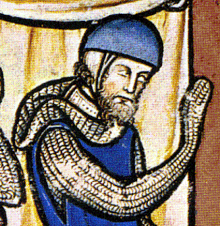cervelliere
Jump to navigation
Jump to search
English[edit]

Etymology[edit]
French cervelière, from Latin.
Pronunciation[edit]
Noun[edit]
cervelliere (plural cervellieres)
- A metal skullcap.
- 1821, Archaeologia: Or Miscellaneous Tracts Relating to Antiquity, page 143:
- Of a certain quantity of leathern coats, of gorgets, cervellieres, &c. of gorgets and cervellieres two hundred and fifty.
- 1842, S.R. Meyrick, A Critical Inquiry Into Antient Armour, as it Existed in Europe, Particularly in Great Britain, from the Norman Conquest to the Reign of King Charles II: Ill, page 24:
- The visored basinet of Eustace de Ribemont is indeed altogether gilt, and as there are tasseled cords which come from underneath, he has probably a cervelliere of mail attached to his camail.
- 2010, Noel Fallows, Jousting in Medieval and Renaissance Iberia, Boydell Press, →ISBN, page 4:
- And they should likewise check that they have not sharpened the vervelles of the cervellieres. Furthermore they should make all the knights swear an oath that they will under no circumstance strike with them in the face […] And furthermore, if anyone's cervelliere or helm should fall off, that he not be struck until he has put it back on.
- 2016, Matthew Bennett, Doyne Dawson, Ron Field, Philip Hawthornwaite, Mike Loades, The History of Warfare: The Ultimate Visual Guide to the History of Warfare from the Ancient World to the American Civil War, Chartwell Books, →ISBN, page 87:
- By 1400 it had developed into a cervelliere, or brain guard, which fitted under the bascinet. Knight c. 1320 A composite armor of mail and plate. Metal poleyns protect the knees, while the shoulder (pauldron) and forearm (lower cannon) ...
- 2016, Bruno Mugnai, History&Uniforms 9 ENG, Soldiershop Publishing, →ISBN:
- The infantry also made an extensive use of iron hats of various kinds but also bascinets with or without camail, and little iron cap known as cervelliere. French and northern European miniatures show similar cervelliere caps (or secret) ...
- 2017, RachelAnn Dressler, Of Armor and Men in Medieval England: The Chivalric Rhetoric of Three English Knights' Effigies, Routledge, →ISBN, page 20:
- William Longespee wears exactly the same mail pieces, including the cervelliere. The knight at Chaddesley Corbett even wears the same combination of fillet around the coif and cervelliere underneath (Figure 32).
- 2017, Ken Mondschein, Game of Thrones and the Medieval Art of War, McFarland, →ISBN:
- Historical counterparts from the medieval period would be most spangenhelms; cervellieres, which were simple one-piece skullcaps; and some sallets, which were fifteenth-century helmets with more shaping to them and protected the nape of ...
- 2017, David Campbell, Longbowman vs Crossbowman: Hundred Years’ War 1337–60, Bloomsbury Publishing, →ISBN:
- The archers all carry sheaves of arrows and knives or swords for personal protection, but for the most part they are lightly equipped, with a few wearing gambesons and cervellieres for protection, the rest in common clothes.
- 2018, Douglas Strong, Surviving Examples of Early Plate Armour (1300-1430): Volume I: Bascinets, ISD LLC, →ISBN, page 9:
- In form, cervellières have a low, rounded skull and extremely shallow cheeks. These do not appear to have ever have been made with a visor of any sort. They also rarely, if ever, show signs of having had vervelles for the attachment of ...
Alternative forms[edit]
Translations[edit]
Translations
|
